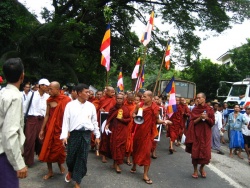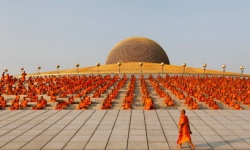Modern Age by: Julia Hardy
In the modern age, Buddhism is characterized by its diversity. In some countries it is a cultural institution. In some it is deeply engaged in political conflicts. Some governments that are in conflict with Buddhism have tried to destroy it. In others countries, Buddhism is just becoming established or evolving in new forms.
In some countries, Buddhism has become an integral part of the cultural landscape. In these countries, there are thousands of temples, large and small. Some have museums where historical works of Buddhist art are displayed and remarkable architecture and landscapes are featured. Other temples are gathering places for locals. One might find a monthly flea market or souvenir shop side by side with people participating in rituals commemorating deceased relatives. There are prominent Buddhist universities where the Buddhist tradition is taught. Buddhist rituals of national importance, such as the ringing of the temple bell on New Year's Eve in Japan, still attract huge crowds. While some experience their Buddhist faith intensely, others say they participate in rituals for cultural reasons rather than as a matter of belief.
In other countries, Buddhism has been in conflict with government authorities. In China, the practice of Buddhism was discouraged for much of the 20th century. Temples and works of art were destroyed, and monks and nuns were forced to return to secular life. Buddhism in China was virtually devastated, and is just beginning to recover. The Chinese government also assimilated Tibet, forcing its political and religious leader, the 14th Dalai Lama, to flee the country. In Tibet, temples and art were also destroyed and monks and nuns were killed or imprisoned.
In Burma (Myanmar), Buddhist monks have recently protested against the current government at their peril. Buddhists have also been involved in political conflicts in Sri Lanka, Cambodia, Laos, Vietnam, and Thailand.
There have been occasions in which Buddhist monks have taken up arms and participated in military conflicts. In Tibet, some monks became resistance fighters, while others employed methods of peaceful protest and were jailed or faced gunfire from police or troops. Even before these events, some Tibetan monks were involved in armed conflicts between rival monasteries. During the Vietnam War, some Buddhist monks became North Vietnamese soldiers.
During the shogun era in Japan, military men took up Buddhist practice as a way of cultivating self-discipline and becoming better fighters. Some Japanese Buddhist monks and scholars renewed this tradition to support their nationalism during World War II.
One can see Buddhist themes in works of art throughout Asia. Buddhism also figures prominently in Asian popular culture, where one may see films or anime with Buddhist themes or Buddhist characters. The dissolute or degenerate Buddhist monk is a frequent stereotype in literature and film, often a comic character.
In some areas of the world Buddhism is growing. There has been a resurgence of Buddhism in India for a number of reasons. The ease of travel in the 20th century has made it possible for Buddhists from other countries to visit sacred sites there, and Buddhists from overseas have contributed substantially to the renewal of these sites. When the Dalai Lama was forced to leave Tibet, he was given Refuge in India. The Indian government also provided land for refugee settlements and education for Tibetan children, thus there is a large Tibetan Buddhist exile population in India.
Buddhism has also been a religion of choice for Indian untouchables. B. R. Ambedkar, an untouchable who was the chief framer of the Constitution for a newly independent India, converted to Buddhism along with half a million others in 1956. This process of conversion to Buddhism by untouchables began in the late 19th century, spurred by Sri Lankan Buddhist monks, and continues to this day, although it is discouraged by some Hindu groups who regard periodic mass conversions as political stunts.
Today some Chinese and Tibetan temples are being rebuilt, some by the government as tourist attractions, others with contributions from overseas Chinese and other Buddhists. In Taiwan, where Buddhism has flourished, new Buddhist charitable organizations have emerged, such as Tzu Chi, supporting hospitals, disaster relief, and education. In Japan, new religions have emerged with strong Buddhist foundations, and a few of these, such as Soka Gokkai, have become international in scope.
Interest in Buddhism in the west began in the 16th century largely due to reports by Jesuit missionaries to China and Japan, and this interest was strengthened in the 19th and 20th centuries as Buddhist texts were translated into western languages and Buddhist monks came to America and Europe to teach. Writers like the Transcendentalists and the Beats incorporated Buddhist ideas into their literature. A marked increase in Asian immigration in the latter half of the 20th century has also contributed to the growth of western Buddhism. Meditation centers, temples, and universities have been built in the United States and Europe, and thousands of books about Buddhism have been published in western languages. Projects to translate the entire Buddhist canon are also underway.
The 14th Dalai Lama, winner of the Nobel Peace Prize in 1989, and the Vietnamese Monk Thich Nhat Hanh (who was nominated for the Nobel Peace Prize by Martin Luther King, Jr., in 1967), are Buddhist leaders who have become enormously popular public figures internationally, publishing many books and attracting crowds to their public appearances.
Westerners, both converts and immigrants from Asia, have also contributed to the revitalization of Buddhism in some areas of Asia. Some scholars of Buddhism argue that this western influence has contributed to what they call the "Protestantization" of modern Buddhism. They suggest that the western foundation in monotheistic religion, and the dominance of Protestant Christianity within the academy, have led western Buddhists and scholars of Buddhism to minimize elements such as ritual, mysticism, and the devotional worship of Buddhist deities, in favor of an emphasis on meditation and philosophy.


